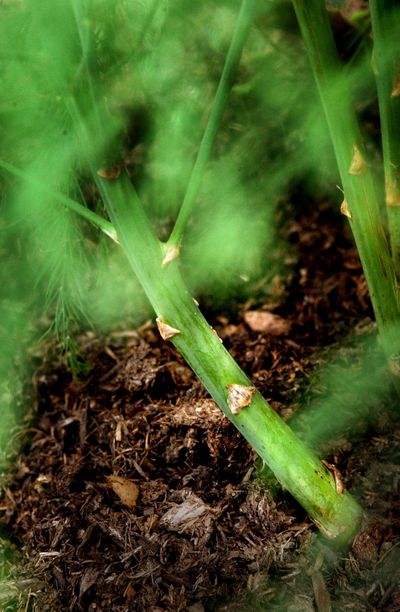Pat Munts: Asparagus grows well in weed-free site

Growing your own asparagus takes some patience, space and time.
Asparagus plants are grown from year-old roots called crowns that are readily available at garden centers this time of the year. It can be grown from seed but this adds an extra year to the point when a harvest is possible. Male varieties such as Jersey Giant, Jersey Knight or Jersey Prince are the best to grow – male plants put more energy into growing fat spears whereas female plants tend to produce smaller spears and put most of their energy into producing seed.
Select a sunny, level site where the plants won’t be disturbed by other crops, ornamentals or weeds; a planting of asparagus will live 20 years or more. Each root will produce about a half a pound of asparagus each year once they are mature, so plan the number of roots accordingly so you get the amount you want.
Prepare the bed carefully, paying particular attention to controlling weeds prior to planting. Asparagus doesn’t tolerate weeds. If possible, prepare the bed the previous fall and then root out any weeds that pop up in the early spring. Asparagus can be planted in any well-drained soil with a pH of about 6 to 7, our normal range in the Inland Northwest. Dig a trench 6 to 8 inches deep and a foot wide. Mix some well-rotted manure or compost and a good quality organic fertilizer into the bottom of the trench and form a mound. Set the roots with the growing point up about 9 inches to a foot apart in the trench. If you are making more than one row, space the rows 3 to 5 feet apart. Backfill the trench with soil but don’t tamp it down. Water the row well and add a little more soil to bring it up to grade.
Keep the bed evenly moist through the first year. New shoots should appear within a week or two. Keep the bed weed free by lightly cultivating it as the new spears appear. A light layer of mulch will help the first year. Apply a balanced organic fertilizer early each spring. Once it is established it is quite drought tolerant.
You can begin harvesting lightly the second spring. Harvest 6- to 8-inch spears for about three weeks by snapping them off at ground level. The second year you can harvest for four to six weeks and thereafter six to eight weeks. Stop when the spears begin to become smaller.
After harvest has finished, snap off any remaining spears and weed the bed well either by hand or with glyphosate. Apply a pre-emergent weed chemical to the bed. Spears that then emerge will grow into ferns that will provide nutrients to rebuild the roots for the next harvest. The ferns can be left standing through the winter to catch snow and cut down to the ground in the early spring.